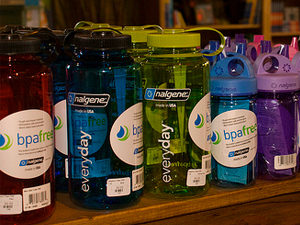Carbon Dioxide Used to Make BPA-Free Plastic

BPA-free bottles - CC license by Flickr user Trailmix.Net
Researchers have found a way to pull carbon dioxide (CO2) out of the air and use it to make plastics that do not containbisphenol A(BPA).
Polycarbonate, the type of plastic used in hard water bottles and various other items, has traditionally contained BPA, a chemical linked to a number of developmental and reproductive effects.
Asmore concern has been raisedover the possible effects of BPA on human health, companies have switched to BPA-free alternatives, such as Eastman Chemical Company'sTritan material, which is being used to make water bottles, baby bottles, blenders and more.
At theInstitute of Bioengineering and Nanotechnologyin Singapore, researchers have developed a way to capture CO2 from the atmosphere and use it to make chemicals that can be turned into BPA-free plastic.
The new materials are able to be 40 percent CO2 by weight. The researchers used organic chemicals called ionic liquids to pull the CO2 from the air and use it, copying how a plant captures and uses CO2 during photosynthesis.
AsEnvironmental Health Newswrites about the research:
Using chemicals called imidazoliums and N-heterocyclic carbenes (NHCs), researchers in Singapore report they were able to couple CO2 with molecules called "epoxides" to form polycarbonates.
The researchers' work is detailed in a study in theEnergy & Environmental Science journal.
BPA-free bottles - CC license by Flickr userTrailmix.Net





